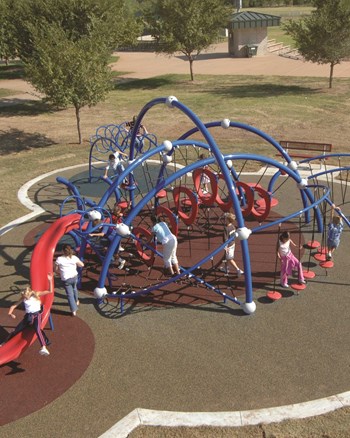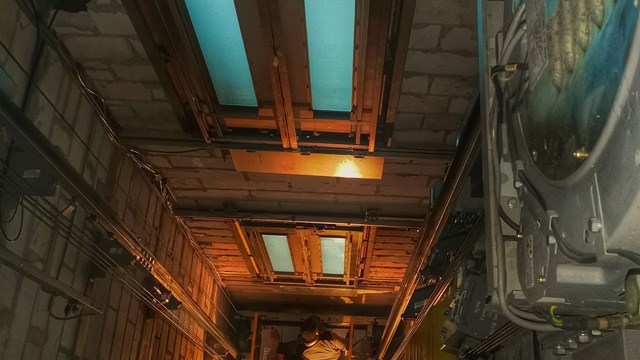
Often when we think of the “good old days,” thoughts of a time before cell phones, Facebook and GPS come to mind, when kids played in public parks stocked with swing sets, monkey bars and maybe (if you were lucky) a basketball hoop and teeter-totter.
Time marches on however, and while there will likely always be a place in our collective hearts for the classic playground swing set, we've come a long way from the days of rusty swings with frayed canvas seats, splintered teeter-totters and faded hopscotch courts. The shift from plain metal-and-asphalt equipment to more colorful and exciting—and safer—equipment really began in the 1990s, and the field has been diversifying and evolving ever since. Today, chances are good that if Sally knocks Johnny off the monkey bars, those bars will be shaped like a DNA double-helix (or some other fanciful shape), and Johnny will not fall onto concrete or pea-gravel, but onto foam padding.
A New Age of Play
According to Ryan Russell, president of Playmore Recreational Products & Services in Fort Myers, “Safety standards in the past 25 years have greatly influenced design of the modern playground. Recently, a lot of manufacturers have began to look outside the box, and are starting to come up with a lot of unique and interesting pieces that still adhere to safety standards.”
Playgrounds began to change in the mid-80s, notes Russell. “The mid-1980’s is when composite structure playgrounds—a series of interconnected elevated decks with climbers and slides hanging off them—appeared on the market,” added Moira Staggs of Illinois-based NuToys Leisure Products.
Prior to that, composite structures were often a combination of wood and metal or plastic slides. Now people have many more options to create a design and color scheme that fits the needs of the user group either by age, level of challenge, or type of activities.
“Safety standards have become more robust and comprehensive over time,” Staggs continues. “Whereas guidelines used to be voluntary, now all playgrounds intended for public use must follow the standards. The three main playground safety standards are the Consumer Product Safety Commission Public Playground Safety Handbook and the ASTM F1487 Standard Consumer Safety Performance Specification for Playground Equipment for Public Use, which cover the safety standards of types of equipment and layout, and the ASTM F1292 Standard Specification for Impact Attenuation of Surface Systems Under and Around Playground Equipment which covers the standards for safety surfacing. Over the years, these standards have made playgrounds much safer for kids.”
There are really two users of playground equipment: the children scrambling over the structures, and the parents or caregivers who want to make sure the scrambling is as safe as possible. According to industry pros, there is a definite split between what is popular among children versus what adults think is fun and/or safe—and bridging that gap can be a big challenge for designers.
“Kids seem to always want to push the boundaries of safety more than most parents, and they always seem to find a way to have fun no matter what,” says Russell. “Parents can be funny, and I try not to judge how they feel about safety. I can install two similar pieces of playground equipment, and one set of parents will have complaints about perceived danger, and the other set of parents will complain that it’s too easy or boring.”
“When it comes to what parents think is fun AND safe, it can be a tricky balance,” concurs Staggs. “Some cautious parents would prefer a very safe playground with low elevations and limited challenge. However, in our experience, if you don’t provide enough challenge for kids in the playground, they will find ways to challenge themselves. Often that means using equipment in ways it was not intended, such as climbing onto the roof, or traversing the tunnel bridge on the top like a balance beam. The key is to design enough age and developmentally-appropriate challenge into the playground to keep kids engaged and keep the playground fun over time.”
Taking into account the propensity of a child to climb and jump, equipment manufacturers have made amazing advances in how kids’s play equipment is made and installed.
“Much of the danger has been taken out over the last 20 years since resilient surfacing became the norm and high-injury elements have been minimized,” according to John McConkey, market insights manager with Landscape Structures in Delano, Minnesota. “Kids like to climb and ride, and they naturally seek a challenge. Some of the most popular items include net climbers, roller slides, spinners, track rides, and climbing walls.”
Equipment today is made to be extremely durable and often is made with recycled materials, the experts say. Moving parts are engineered so that they are allowed to last and allows kids to have more fun, interest, and challenge on playgrounds. Some custom options may include steel-reinforced cable climbers, custom graphics, or glass fiber-reinforced concrete that can be molded to look like a tree, or other nature inspired element. Lots of different materials are available, however per the standards they must be durable, safe and easily maintained.
“The older wood and galvanized steel equipment has now be replaced with materials such as coated steel decks, powder-coated steel and aluminum posts and rotationally molded plastics,” says Staggs. “These materials have made playground equipment production more standardized, which has increased its quality and consistency, which in turn has made it easier to install. The whole process has become more standardized and that ultimately translates to safety.”
A Community Project
If a homeowner association or condo board is planning to install new equipment, or to construct a play area from scratch, there are a few steps to take. Staggs suggests, “The first step is to form a committee that can address the main issues (raising funds, assessing the community and user needs, manage the timeline, identifying space, etc.). It is best to assign responsibilities and set a schedule so the project moves forward on a timeline.”
McConkey suggests that local playground equipment company representatives can be a great resource. “A good representative is up to date on standards, products, budgeting, and installation methods,” he says. “Your local parks department may be a good place to ask which firms offer the best customer service over the long term.”
When choosing equipment for your building or community, safety is obviously of paramount concern, but it’s also important to consider the ages of the children in the community. An experienced vendor can also assist with making recommendations for equipment and design. “Often the community can begin by identifying the ages of the children who will use the equipment, space available, and budget,” says Staggs. “These will then help guide the dealer to make realistic recommendations.”
According to McConkey, condo and homeowner associations should keep in mind that while manufacturers carry liability insurances, individual installers must be certified, licensed and bonded. Russell adds that boards and managers should also look for “companies that have a track record in manufacturing and supplying playground equipment over an extended period of time. Like a lot of industries, companies come and go and you need to find someone that will be around. Compare features and benefits such as durability, warranty, innovation, value, service, and longevity,” he says.
Welcome to the Jungle-Gym
If money is no object, some of the deluxe, high-end equipment available for playgrounds combine modern safety measures with wild imagination, as well as some more familiar traditional themes. McConkey explains that some of these items include “custom-designed equipment that can create a sense of place for the community by emulating a historic event, cultural heritage or icon, or even a geological formation unique to the region. Nature-inspired tree forts, concrete climbing elements that emulate rock formations, there are lots of iconic theme elements to choose from, such as trains, riverboats, bridges and buildings.”
Russell says the latest advancements include “rope play, theme play (ships, castles, jungles, etc), and anything that is electronic.”
And if money is an object—and let's be honest, for most communities it definitely is—there are modular, customizable options that are much less expensive than the top-shelf products, yet far safer and more fun than rustling up a bunch of lumber and nails and building something by hand.
Appealing as a DIY-playground might sound to the handy-around-the-house board or committee, Staggs and McConkey both advise against it. “It is not very advisable to just nail together some 2-x-4’s and let kids climb on them,” says Staggs. “That creates hazards in both the short and long term that may not be evident to the well-meaning creators—things like entanglement hazards, head entrapment, structural failure, and pinch points.”
“It’s not recommended for an owner to build from scratch,” concurs McConkey. “Often the material options don't meet the standards for durability and maintainability.” However, that being said, communities can certainly hold a ‘Community Build’ in which they work with a manufacturer’s representative and certified installer will guide volunteers to construct the playground [from purchased, prefabricated components.] These events can build community, instill ownership in the playground, and in some cases save money on the overall project cost, he adds.
All of the experts stress the importance and value of a great playground. The “good old days” aren't a thing of the past. Even with the distractions of the Internet, computer games and social networking, kids still need to be active and physical. There is even a resurgence of interest in play equipment, as more parents and communities encourage kids to get off the couch and onto their feet.
“It is imperative that children still get out and play,” states McConkey.
Rebecca Fons is a Chicago-based freelance writer and a frequent contributor to The South Florida Cooperator.






Comments
Leave a Comment